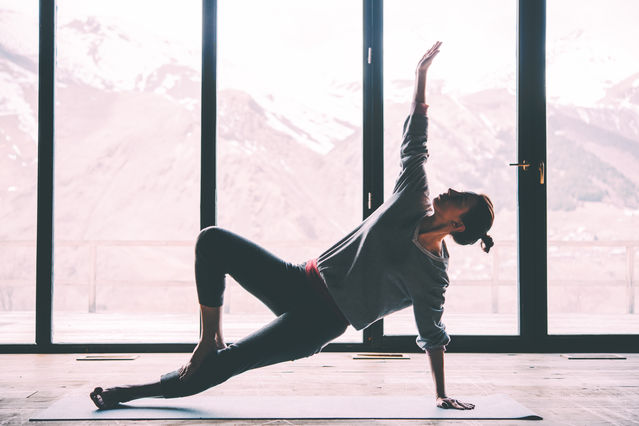Anxiety
How Can Yoga Make Your Life Better?
Discover 6 reasons why yoga is more popular than ever.
Posted June 28, 2019
When I was a kid growing up in the Midwest, I never saw a yoga studio. I may have heard the word “yoga” but had no concept of what it was. Now there seem to be yoga studios everywhere—apparently at least half a dozen within a 15-minute drive from my old house—and our kids were introduced to it in kindergarten.
What explains the explosion of yoga studios and practice in the last few decades? What are the common benefits that draw people to it?

I recently spoke with yoga instructor Tim Senesi on the Think Act Be podcast about the positive effects of yoga. Tim hosts the popular Yoga with Tim channel on YouTube and holds yoga retreats all over the world. Here are six of the benefits that emerged from our discussion.
1. Reclaiming control of your own happiness.
One of the basic tenets of cognitive therapy is that our interpretation of events—and not the events themselves—determines our happiness. Epictetus, a Stoic philosopher, captured this idea in his famous quote, “People are not disturbed by things, but by the view they take of them." Similarly, Martha Washington said that “The greater part of our happiness or misery depends upon our dispositions, and not upon our circumstances.”
I’m sure you’ve experienced this principle in your own life. For example, you might have been feeling down about something, maybe feeling like you've gotten a raw deal, and then you learn about someone who’s suffering much more than you are. Suddenly you notice what’s right in your life, and feel gratitude for your situation even though it’s exactly the same as it was before.
Tim came to this realization through yoga. “I used to think that all my problems were the result of the world around me,” said Tim. “But yoga philosophy and the practice itself shifted my awareness to looking at myself and seeing that I actually have more power than I give myself. And I was able to see that my actions were creating my reality.”
For Tim, yoga became a “laboratory to look inward” and examine what he was creating in his life and why which led to what he describes as a paradigm shift in his approach to living.
Action Step: Look for times today when you’re outsourcing your happiness; is it possible to reclaim the final say in how you feel and act?
2. Supporting other positive life changes
Psychologist Rachel Hershenberg describes “keystone habits” in her self-help book on treating depression. These habits are not only beneficial themselves, but help other healthy behaviors fall in place.
For example, when I was training for triathlons a few years ago, I was more conscientious about my sleep, alcohol consumption, and the foods I ate, because I wanted those behaviors to support my training. Other examples could include a consistent sleep schedule or spending time outdoors.
Yoga can be a keystone habit in the same way, as Tim describes in his origin story. "I noticed that when I participated in drinking or getting high, I didn’t feel the same connection and relief that I felt at the end of my first yoga class," he said. "Pretty soon I was practicing yoga every day, so there was no more time to eat junk or stay out late drinking as I knew I wouldn’t like how I felt the next morning on the mat. Yoga slowly changed my life, one day at a time."
Action Step: Identify your own keystone habit—one positive behavior that catalyzes others.
3. Fostering mindfulness practice
Yoga is inherently a mindful practice. Some of the mindfulness elements come from traditional meditation, such as spending a few minutes focusing on the breath at the beginning of a class. (Check out Tim's meditation series on his channel.)
But all of yoga can be an exercise in mindful action—bringing one’s full awareness to the practice and opening to what happens on the mat. Instructors like Tim often remind their students to stay present and focused during their class, rather than allowing the mind to fixate on the future or the past.
Tim found that yoga was a key way to practice letting go, which is a core aspect of mindful living (see, for example, this article by Pema Chödrön). He described using the Corpse Pose (Savasana) at the end of a yoga class to practice letting go, using the metaphor of entering a temple and approaching the altar. Yoga practice itself could be seen as the temple, and you can “offer up all the things that prevent you from being present—all your ‘baggage’” as you enter the “temple” of your yoga practice. Then, while lying in Savasana, “You can approach the altar and offer up anything you weren’t able to leave outside.”
Action Step: When you wash your hands today, be aware of the full experience—the sound of the faucet, the feel of the water, the scent and slipperiness of the soap, the movements of your hands against each other, and the sensations of drying your hands. (Adapted from The CBT Deck)
4. Reducing anxiety
Yoga has long been recognized for its ability to decrease anxiety. When I’m providing psychotherapy for someone with high anxiety, I often recommend yoga as part of their treatment. This is not to say that yoga “solves” anxiety, but it can be an important component of dealing with it.
“There’s definitely an element of anxiety that comes from a lack of bodily awareness,” Tim said. That idea certainly resonates with my clinical work, and my own personal experience. I often hear people describe feeling anxious and “stuck in their head.” Tim continued, “When we’re more in tune with our body, then that affects the mind.”
Tim noted the role of the breath in particular in affecting anxiety. “Most people tend to breathe between 12 and 20 breaths per minute,” he said. In contrast, yoga helps us slow down and deepen the breath. “When you’re practicing yoga, you’re slowing down your breath to around six breaths per minute,” said Tim. “Practicing this slow, rhythmic breathing has a very soothing effect on your mind.”
See this previous post for other reasons that yoga tends to reduce anxiety.
Action Step: Try Tim's brief guided Mindfulness Meditation for Stress and Anxiety.
5. Managing stress
Yoga can be a great way to manage routine stress, even for those who don’t experience high levels of anxiety. Not surprisingly, the highly effective Mindfulness-Based Stress Reduction program includes slow, deliberate yoga postures, with a focus on connecting to the movement and the breath.
As Tim noted for anxiety, the breath is directly connected to our stress level. “When you’re used to practicing shallow breathing, it's exciting to the nervous system,” he said. “If I’m breathing in a stressful way all the time, I’m already heightened and ready to react.”
In contrast, consistently practicing slowing the breath, as you do in yoga practice, trains you to “breathe fully into your lungs,” which “has a direct effect on your mental serenity.” That positive effect likely comes from the connection between the breath and the vagus nerve, which is crucial for allowing our parasympathetic nervous system to balance the fight-or-flight mode of the sympathetic nervous system.
With consistent practice, we can change our habitual response to stress. Lowering our baseline level of stress and tension puts us in a better place to respond when we encounter a challenge. “If I can slow down and be with my breath a little more instead of reacting, I can process and act a little better.”
As Tim noted, yoga can also be your “lab” where you study how you respond under stress. If you’ve taken many yoga classes, you probably know that many of the poses can be challenging, and provoke all kinds of mental and emotional reactions. By practicing staying with a challenge—even embracing it—rather than fighting it or fleeing, we can reprogram our typical response to stress. We can even find a sense of ease in the middle of a difficult pose, or unexpected life problem.
Action Step: Schedule a time in your calendar to do something relaxing and enjoyable, whether a yoga class, a walk outside, time in your garden, or anything else.
6. Promoting physical health
Finally, the benefits of yoga aren’t limited to mental, emotional, and spiritual. Consistent yoga practice can increase strength, flexibility, and balance. It can dramatically improve core strength, too, which is crucial for preventing injuries, including to the back. As Tim mentions in some of his videos, yoga practice was instrumental in helping him to heal from his own serious injuries.
As we age, injuries can have a tremendous effect on our mental and emotional well-being, and our basic ability to do the activities we enjoy. I’ve treated many people in my clinical practice who were dealing with the fallout of debilitating injuries, and have seen the ripple effects in my own life when I’m struggling physically.
Action Step: Try this Yoga Flow for Core Strength video from Yoga with Tim, which showcases his unique instructional style. Always consult with a qualified health professional before starting any physical exercise.
The full conversation with Tim Senesi is available here: How to Get the Most Out of Your Home Yoga Practice.




